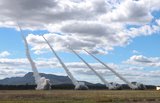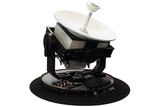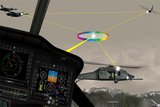USAF launched second GPS III satellite
The US Air Force has launched its second GPS III satellite, part of a constellation of up to 32 satellites that will bolster the US’ navigation capabilities.
The satellite, nicknamed ‘Magellan’ by USAF, was launched from Cape Canaveral Air Force Station on 22 August, and partners on the development of GPS III include Lockheed Martin, BAE Systems, L3Harris and Raytheon.
The GPS III SV02 is the second example of this satellite designed and built by Lockheed Martin to be launched to help USAF modernise its GPS constellation, and will provide three times more accuracy and up to eight times improved anti-jamming capabilities than legacy systems did.
GPS III also provides a new L1C civil signal, which is compatible with other international global navigation satellite systems, including Europe's Galileo constellation.
‘GPS III SV02 is receiving and responding to commands just as planned. In the days ahead, we'll finish orbit raising to our operational slot and then send the satellite commands telling it to deploy its solar arrays and antennas,’ Johnathon Caldwell, Lockheed Martin Space's vice president for navigation systems, said.
‘Once we are set up, we'll begin on-orbit checkout and tests, including extensive signals testing with our advanced navigation payload.’
GPS III satellites are being produced at Lockheed Martin's GPS III processing facility near Denver, and on 27 May, the air force declared the GPS III SV03 as being available for launch, which is now in storage waiting for a launch date.
GPS III SV04-08, meanwhile, are now in various stages of assembly and test.
Lockheed is under contract to build up to 32 GPS III/IIIF satellites for the air force, and additional ‘IIIF’ capabilities will start being added at the 11th satellite.
These include a fully-digital navigation payload, a regional military protection capability, an accuracy-enhancing laser retroreflector array, and a search and rescue payload.
BAE Systems provided its RAD750 single board computer (SBC) for L3Harris’ navigation payload for GPS III, and the SBC will provide radiation hardened, onboard processing capability for the satellite's mission.
‘Security and reliability are key to ensuring war fighters can depend on GPS signals,’ James LaRosa, director of space processor and products at BAE Systems, said.
‘Our rad-hard RAD750 processor can withstand radiation doses a million times stronger than a fatal human dose, and that durability is valued on missions like the GPS III.’
Raytheon, meanwhile, delivered a GPS Next-Generation Operational Control System (GPS OCX) for the programme.
‘GPS OCX performed extremely well during the first launch, and has exceeded performance requirements in the months since,’ Dave Wajsgras, president of Raytheon Intelligence, Information and Services, added.
‘The team was well-prepared for this launch, and we're confident the system's performance will continue to be positive.’
In addition to GPS OCX, Raytheon is involved in the RGNext joint venture with General Dynamics Information Systems, which is providing operational launch support for the United Launch Alliance's Delta-IV rocket that carried the GPS III satellite.
RGNext operates the launch range on behalf of USAF, providing maintenance, range safety, weather monitoring, communication and surveillance support for all launches conducted by defence, civil and commercial companies at the range.
More from Five Eyes Connectivity Special Report
-
![Podcast: Five Eyes Connectivity - Canada]()
Podcast: Five Eyes Connectivity - Canada
In this episode of the Five Eyes Connectivity podcast, we look at the unique situation faced by Canada and how its military is responding to a rapidly changing world.
-
![Podcast: Five Eyes Connectivity - Australia and New Zealand]()
Podcast: Five Eyes Connectivity - Australia and New Zealand
In this episode of the Five Eyes Connectivity podcast, we hear how two of the smaller militaries in the Five Eyes alliance – Australia and New Zealand – are responding to a rapidly-changing world.
-
![Podcast: Five Eyes Connectivity - The United Kingdom]()
Podcast: Five Eyes Connectivity - The United Kingdom
In this episode of the Five Eyes Connectivity podcast, we hear how a rapidly shifting threat environment is driving a transformation of British military capabilities.
-
![Podcast: Five Eyes Connectivity - The United States]()
Podcast: Five Eyes Connectivity - The United States
In this episode of the Five Eyes Connectivity podcast, we dive into the connectivity issues facing the US military and its further development of the Multi-Domain Operations concept.
-
![Australian CHORUS is on song]()
Australian CHORUS is on song
The Australian Department of Defence announced on 11 May that it is exploring ways to integrate laser-based optical and RF communication technologies onto a single …
-
![Tactical data link provider expects major new order this month]()
Tactical data link provider expects major new order this month
Looking to the future of the Multifunctional Informational Distribution System Joint Tactical Radio System (MIDS JTRS), BAE Systems expects an imminent new production contract and …
























